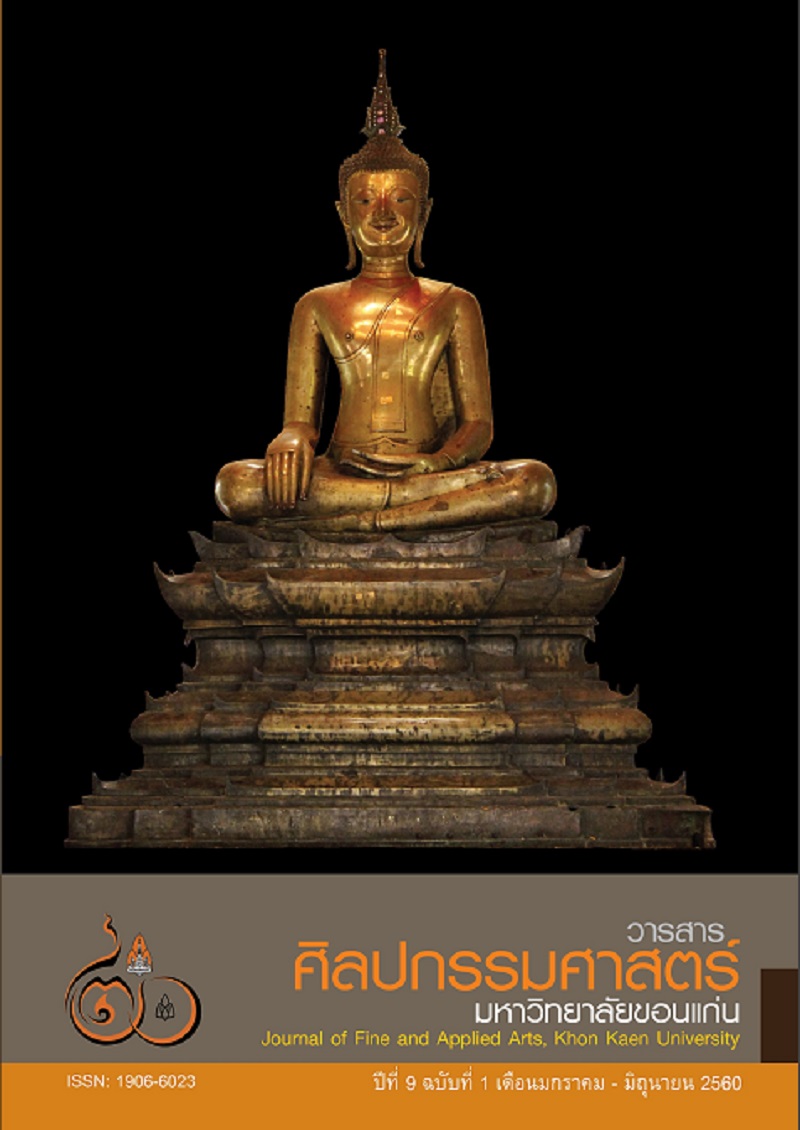ไหมแต้มหมี่: จากภูมิปัญญาสู่นวัตกรรมการผลิตผ้าทอมือลายมัดหมี่ Mai Taem Mi: From Local Wisdom to the Innovation of Tie-Dye Woven Fabric Production
Main Article Content
Abstract
การพัฒนากระบวนการผลิตผ้าไหมมัดหมี่ด้วยเทคนิคการแต้มสีเป็นการแก้ปัญหาการผลิตผ้าไหมลายมัดหมี่ที่ต้องใช้ระยะเวลานานในการมัดหมี่และย้อมแต่ละสี เกิดข้อจำกัดในการรับคำสั่งซื้อ และการสืบทอด การแก้ปัญหาดังกล่าวกระทำโดยการศึกษากระบวนการผลิตผ้าไหมมัดหมี่ การทดลองเพื่อลดกระบวนการผลิตผ้าไหมลายมัดหมี่ และการเผยแพร่เพื่อส่งต่อองค์ความรู้ไปสู่กระบวนการผลิตในระดับชุมชน จากการศึกษาและทดลองสามารถลดกระบวนการผลิตผ้าลายมัดหมี่ได้ด้วยการใช้การแต้มหมี่ด้วยสีรีแอคทีฟชนิดระบายบนโฮงมัดหมี่ทุกสีพร้อมกันในครั้งเดียวแทนการมัดหมี่แบบเดิมร่วมกับขั้นตอนการแช่สารกันสีตก ซึ่งสามารถลดระยะเวลาในการผลิตผ้าไหมทอมือลายมัดหมี่ลงได้โดยยังใช้อุปกรณ์เดิม สามารถสร้างลายมัดหมี่ได้ง่ายขึ้นเอื้อต่อการสืบทอด และกลุ่มชุมชนสามารถสร้างสรรค์ลวดลายต่อไปด้วยตนเองจากพื้นฐานเดิม โดยลวดลายที่เหมาะสมสำหรับเทคนิคนี้เป็นลายที่มีขนาดใหญ่และมีความอิสระคล้ายการระบายสีด้วยพู่กัน
The development of tie-dye silk fabric production process using a touch-up dye technique is a solution to traditional tie-dye silk fabric production which takes longer time in making as it has to dye each color each time. Thus, the long process has resulted in limited purchase orders and interests in continuation of the wisdom. The solution to this problem came from the studies and experiments to reduce the tie-dye silk fabric production processes. The new set of knowledge found is aimed to promote to the community production level. The results reveal that tie-dye silk fabric production processes can be reduced by a touch-up technique using all necessary reactive paint colors on the tie-dye tool (Hong Mudmee) at once using color sealing process. Able to use the traditional tie-dye tools and objects, the new technique can reduce time used comparing to the traditional process. In addition, new tie-dye patterns can be created which increases more interests to continue this wisdom. The community then can continue to create new patterns on their own based from their traditional knowledge. The patterns suitable for this new technique are those of large sizes and free forms similarly to painting with brush.
Article Details
Content and information in articles published in the Journal of Fine and Applied Arts of Khon Kaen University is regarded as the opinion and sole responsibility of the author(s) directly; therefore, editors are not obliged to agree to or share any responsibility with regard to the content and information that appears within these articles.
All articles, information, content, image, etc. that have been published in the Journal of Fine and Applied Arts of Khon Kaen University is the copyright of the Journal of Fine and Appllied Arts of Khon Kaen University. Any person or organization who wishes to distribute all or parts of the articles for further dissemination or other usage must first receive permission from the Journal of Fine and Applied Arts of Khon Kaen University before proceeding to do so.


